When you’re trying to eat healthfully, it’s essential to keep track of just how much you’re eating. It’s all too easy to misjudge correct portion sizes.
Here are some easy comparisons to help you figure out how many servings are on your plate.
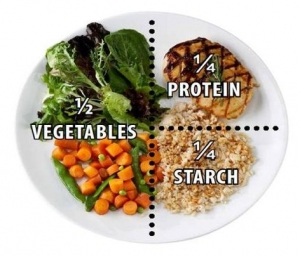 Portion Size Your Plate
Portion Size Your Plate
½ PLATE VEGETABLES:
Fill half your plate with a colorful assortment of different vegetables for good nutrition and tastes to please your palate.
¼ PLATE PROTEINS:
Low-fat proteins are good for your heart and better for your waistline. Bake, broil,
or grill your way to a delicious and healthy meal.
¼ PLATE STARCHES:
Whole-grain starches are good for your heart and keep you feeling fuller longer.
While foods like yams, potatoes and corn are considered vegetables, they are high
in starch and should be placed on this part of your plate.
 The Visual Portion Guide
The Visual Portion Guide
The Visual Portion Guide will help you more accurately estimate the portion sizes of the food you eat.
It may be beneficial to think in terms of the size of common objects to get a better idea of just what a serving of food looks like. Here are some quick reference serving sizes:
- A cup of raw vegetables is about the size of a fist.
- One piece of fruit is visually equal to a tennis ball.
- A half-cup of cooked beans is similar in size to a light bulb.
- Two tablespoons of peanut butter is visually comparable to a golf ball.
- A single-serving baked potato is the size of a computer mouse.
- One cup of cereal is about the size of a baseball.
- Three ounces of cooked meat is close in overall size to a deck of cards.
- An ounce of cheese is around the size of four stacked dice.
Basic Guidelines
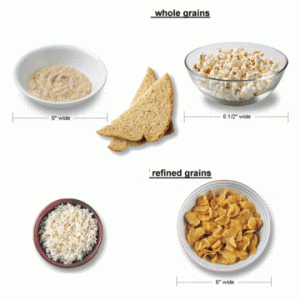 Grains
Grains
Any food made from wheat, rice, oats, cornmeal, barley or another cereal grain is a grain product. Bread, pasta, oatmeal, breakfast cereals, tortillas, and grits are examples of grain products.
Two servings (two ounces total) from the grains is recommended daily.
In general, 1 slice of bread, 1 cup of ready-to-eat cereal, or ½ cup of cooked rice, cooked pasta, or cooked cereal can be considered as 1 ounce equivalent from the Grains Group. See chart: What counts as an ounce equivalent of grains?
1 cup of cereal flakes = baseball
½ cup of cooked rice = light-bulb
½ cup cooked pasta = Baseball
1 slice of bread = cassette tape
3 cups popcorn = 3 baseballs
FRUITS & VEGETABLES
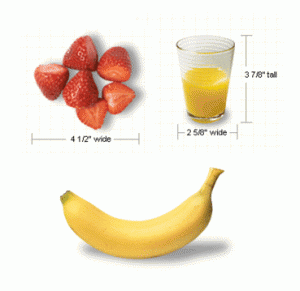 Fruit
Fruit
One serving of fruit is 1/2 cup. Two servings or one cup of fruit a day is recommended.
1 cup of fruit or 100% fruit juice, or 1/4 cup of dried fruit can be considered as 1 cup from the Fruit Group. The following specific amounts count as 1 cup of fruit (in some cases equivalents for ½ cup are also shown) towards your daily recommended intake: See Chart: What counts as a cup of fruit?
1 medium fruit = baseball
½ cup grapes = about 16 grapes
1 cup strawberries = about 12 berries
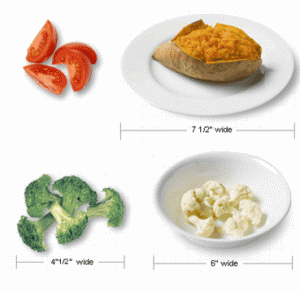 Vegetables
Vegetables
A minimum of two cups of vegetables are recommended daily.You can add more vegetables to your diet as long as they are not starchy vegetables.
1 cup of raw or cooked vegetables or vegetable juice, or 2 cups of raw leafy greens can be considered as 1 cup from the Vegetable Group.
1 cup of salad greens = baseball
1 cup carrots = about 12 baby carrots
1 cup cooked vegetables = baseball
1 baked potato = computer mouse
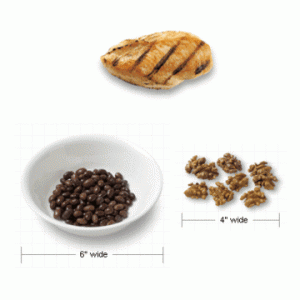 Meat-Fish-Nuts
Meat-Fish-Nuts
All foods made from meat, poultry, seafood, beans and peas, eggs, processed soy products, nuts, and seeds are considered part of the Protein Foods Group. Beans and peas are also part of the Vegetable Group.
Five ounces from the meat-fish-nut group is recommended daily
In general, 1 ounce of meat, poultry or fish, ¼ cup cooked beans, 1 egg, 1 tablespoon of peanut butter, or ½ ounce of nuts or seeds can be considered as 1 ounce equivalent from the Protein Foods Group. See Chart: What counts as an ounce equivalent in the Protein Foods Group?
3 oz lean meat & poultry = deck of cards
3 oz grilled/baked fish = checkbook
3 oz tofu = deck of cards
2 tbsp peanut butter = golf ball
2 tbsp hummus = golf ball
¼ cup almonds = 23 almonds
¼ cup pistachios = 24 pistachios
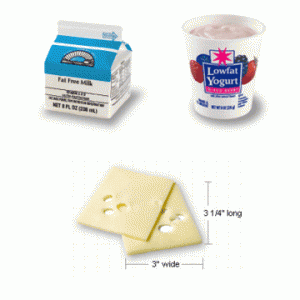 Dairy and Cheese
Dairy and Cheese
All fluid milk products and many foods made from milk are considered part of this food group. Most Dairy Group choices should be fat-free or low-fat. Foods made from milk that retain their calcium content are part of the group. Foods made from milk that have little to no calcium, such as cream cheese, cream, and butter, are not. Calcium-fortified soy-milk (soy beverage) is also part of the Dairy Group.
In general, 1 cup of milk, yogurt, or soy milk (soy beverage), 1 ½ ounces of natural cheese, or 2 ounces of processed cheese can be considered as 1 cup from the Dairy Group.
Amount That Counts as a Cup in the Dairy Group |
Common Portions and Cup Equivalents |
|
|---|---|---|
| Milk (choose fat-free or low-fat milk) |
1 cup milk | |
| 1 half-pint container milk | ||
| ½ cup evaporated milk | ||
| Yogurt (choose fat-free or low-fat yogurt) |
1 regular container (8 fluid ounces) |
1 small container (6 ounces) = ¾ cup |
| 1 cup yogurt | 1 snack size container (4 ounces) = ½ cup |
|
| Cheese (choose reduced-fat or low-fat cheeses) |
1 ½ ounces hard cheese (cheddar, mozzarella, Swiss, Parmesan) | 1 slice of hard cheese is equivalent to ½ cup milk |
| ⅓ cup shredded cheese | ||
| 2 ounces processed cheese (American) | 1 slice of processed cheese is equivalent to ⅓ cup milk | |
| ½ cup ricotta cheese | ||
| 2 cups cottage cheese | ½ cup cottage cheese is equivalent to ¼ cup milk | |
| Milk-based desserts (choose fat-free or low-fat types) |
1 cup pudding made with milk | |
| 1 cup frozen yogurt | ||
| 1 ½ cups ice cream | 1 scoop ice cream is equivalent to ⅓ cup milk | |
| Soymilk (soy beverage) |
1 cup calcium-fortified soymilk | |
| 1 half-pint container calcium-fortified soymilk |
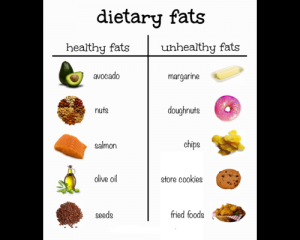 Fats and Oils
Fats and Oils
Oils are fats that are liquid at room temperature, like the vegetable oils used in cooking. Oils come from many different plants and from fish. Oils are NOT a food group, but they provide essential nutrients. Therefore, oils are included.
Foods that are mainly oil include mayonnaise, certain salad dressings, and soft (tub or squeeze) margarine with no trans fats. Check the Nutrition Facts label to find margarines with 0 grams of trans fat. Amounts of trans fat are required to be listed on labels.
Most oils are high in monounsaturated or polyunsaturated fats, and low in saturated fats. Oils from plant sources (vegetable and nut oils) do not contain any cholesterol. In fact, no plant foods contain cholesterol.
A few plant oils, however, including coconut oil, palm oil, and palm kernel oil, are high in saturated fats and for nutritional purposes should be considered to be solid fats.
Solid fats are fats that are solid at room temperature, like butter and shortening. Solid fats come from many animal foods and can be made from vegetable oils through a process called hydrogenation. See Chart: How much is my allowance for oils?
 1 tbsp butter or spread = poker chip
1 tbsp butter or spread = poker chip
1 tbsp salad dressing = poker chip
1 tbsp mayonnaise = poker chip
1 tbsp oil = poker chip
See Chart: How do I count the oils I eat?
SWEETS & TREATS
Currently, many of the foods and beverages Americans eat and drink contain empty calories – calories from solid fats and/or added sugars. Solid fats and added sugars add calories to the food but few or no nutrients. For this reason, the calories from solid fats and added sugars in a food are often called empty calories. Learning more about solid fats and added sugars can help you make better food and drink choices.
Solid fats are fats that are solid at room temperature, like butter, beef fat, and shortening. Some solid fats are found naturally in foods. They can also be added when foods are processed by food companies or when they are prepared.
Added sugars are sugars and syrups that are added when foods or beverages are processed or prepared.
When trying to lose weight, you should limit your Empty Calories to no more then 100 calories for women and 150 for men.
See Chart: How do I count the empty calories I eat?
 Pay Attention to Portion Sizes
Pay Attention to Portion Sizes
When eating out or buying packaged foods, pay attention to portion sizes. Portion sizes are not the same as the serving sizes listed on the Nutrition Facts label. A portion is the amount of food served in one eating occasion. A serving size is a standardized amount of food, such as a cup or an ounce, which is used to provide dietary guidance or to make comparisons among foods. The portions served at fast-food and other restaurants have grown a lot in recent years.
Pay attention to the serving size and the number of servings in the package. A package might contain two or more servings, so if you eat two servings, you would consume twice the calories, fat, sodium, carbohydrates, protein, etc., as you would for one serving.
Whether you’re eating out or at home, one portion may be much more food — and many more calories — than the amounts recommended for a specific daily calorie level.
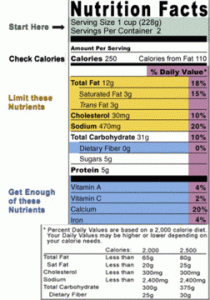 Look at Serving Sizes
Look at Serving Sizes
Also, read the Nutrition Facts label on packaged and canned foods. It tells you the serving size, how many servings per container, calories, calories per serving and key nutrients the food provides. You can use it to help you keep track of how much fat, saturated fat, trans fat, sodium, cholesterol, sugars, and calories you get from different foods.
(Note: The FDA recently proposed updates to the Nutrition Facts label to reflect the latest scientific information linking diet and chronic diseases like obesity and heart disease. Proposed updates include a new design that better highlights key parts of the label such as calories and serving sizes.)
A woman reading the Nutrition Facts Label – Click to enlarge in new window.
Click for more information
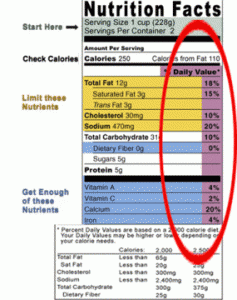 Check Out the Nutrient Content
Check Out the Nutrient Content
The Percent Daily Value (written as “% daily value”) on the right of the label tells you what percentage of the recommended daily amount of a nutrient is in one serving of the food. It is based on the nutritional needs of a person who consumes 2,000 calories per day. For example, on this label for macaroni and cheese, the Percent Daily Value for total fat is 18%. This means that one serving of macaroni and cheese (1 cup) will give you 18 percent of the total amount of fat you should allow yourself each day, assuming you eat about 2,000 calories daily.


